Study results show the potential to process P. monodon processing waste into value-added food ingredients
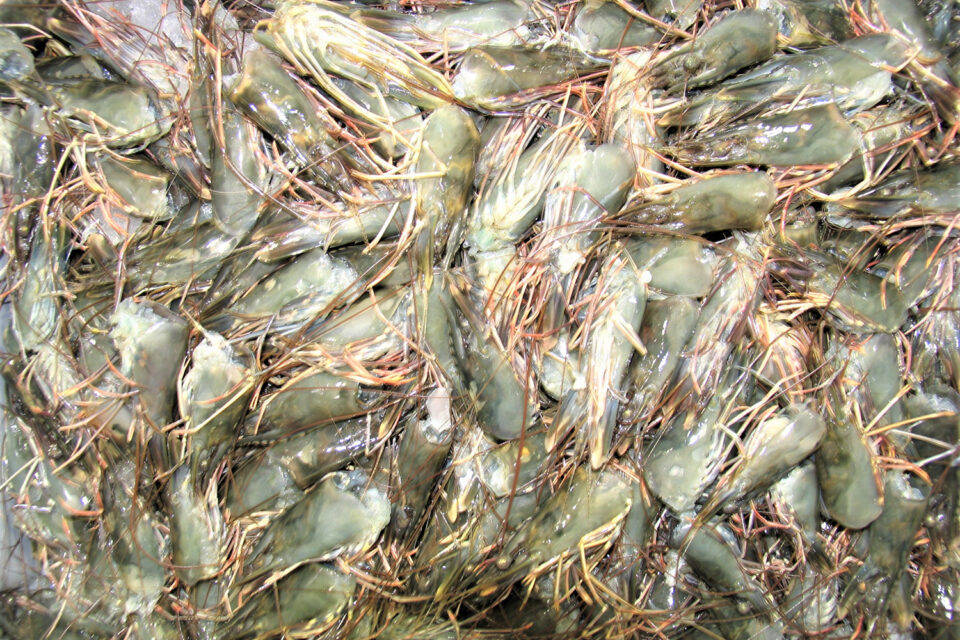
Large quantities of wasted shrimp byproducts are generated every year by shrimp processing industries globally, in the form of heads and carapace. These wastes comprise 48.5 to 56 percent by weight of the shrimp raw material, depending on the species. The underutilization of shrimp head wastes poses a problem for the processing plants and improper disposal of these wastes can contribute to environmental issues on a larger scale. Seafood wastes contain a large amount of organic matter, flesh particles, breading, soluble proteins and carbohydrates. In addition, shells and appendages may also increasing the waste load and provide excessive nutrients to the adjacent bodies of water, increasing the biochemical oxygen demand and reduce the oxygen concentration in water.
The Philippines produces about 24,000 tons of black tiger shrimp (Penaeus monodon) and 30,000 tons of Pacific white shrimp (Litopenaeus vannamei) annually. Sixty percent are for the domestic market, and the remaining 40 percent are exported after processing per different buyers’ requirements and specifications. These are processed either as whole (shrimp is left with head and shell intact), headless (head is removed with shell intact), and peeled [head and shell are removed, or in some cases veins (intestines) are also removed]. Removes heads and carapaces are commonly discarded as wastes, and most shrimp processing plants can generate about one ton of shrimp head wastes per day.
These wastes are good sources of marine protein and oils. Major components of shrimp head are protein (54.4 percent), minerals (21.1 percent), lipids (11.9 percent), chitin (9.3 percent), and small amounts of valuable carotenoid pigments. These valuable compounds can add substantially to overall profitability after appropriate processing. However, there are only a few published studies on the processing of shrimp wastes.
This article – adapted and summarized from the original publication (Bassig, R.A. et al. 2021. Utilization of Shrimp Head Wastes into Powder Form as Raw Material for Value-Added Products) – reports on a study to transform shrimp head wastes from P. monodon processing into a ready-to-use powder with high nutritional value.
Study setup
A total of 70 kg of fresh chilled, black tiger shrimp head (SH) wastes were obtained from a commercial shrimp processing plant in Meycauayan, Bulacan, Central Luzon. The SH were packed in high-density polyethylene (HDPE) container and transported to the National Fisheries Research and Development Institute (NFRDI) processing laboratory in Quezon City. The temperature of the SH was maintained at close to zero degrees-C during transport, and were later washed, drained, packed, and frozen (minus-18 degrees-C) before processing.
The shrimp parts were prepared for analysis as shrimp waste with carapace (SHwc) and shrimp waste without carapace (SHwoc). Samples were ground and cooked to produce pastes, which were then frozen. The frozen shrimp pastes were brought to the Department of Science and Technology – Industrial Technology Development Institute (DOST-ITDI), Bicutan, Taguig City, for analysis.
For detailed information on processing yields and various product quality variables, including proximate composition, color and others; sensory evaluation and shelf-life determination and other analyses, refer to the original publication.
Results and discussion
The removal of the carapace and other SH appendages during cleaning or washing caused a significant decrease in the weight of SHPwoc, and two hours of cooking in both treatments caused a loss of more than 30 percent due to the evaporation of moisture. Nevertheless, the SHPwc product had a yield approximately 6 percent higher than the SHPwoc. Our yields are about 5 to 11 percent higher than those reported by other researchers processing shrimp wastes into flour, and about 13 to 19 percent lower than the shrimp flavor powder yield determined by another research group. We believe our percent yield is of significant economic and industrial value.
Our data for the proximate composition of fresh shrimp heads (FSH) agree with the findings of other researchers using P. monodon and L. vannamei. With the reduction of water through drying, the other components in both SHP products were concentrated, explaining the increase in percentages of protein, fat, and ash components. The protein content of both SHPwc and SHPwoc was very similar to the values reported from other studies, as was the ash content of our SHPwoc, but the fat content of both SHP products in our study was higher. High ash content in shrimp head powder is due to the mineral content of shrimp byproducts, mostly calcium carbonate.
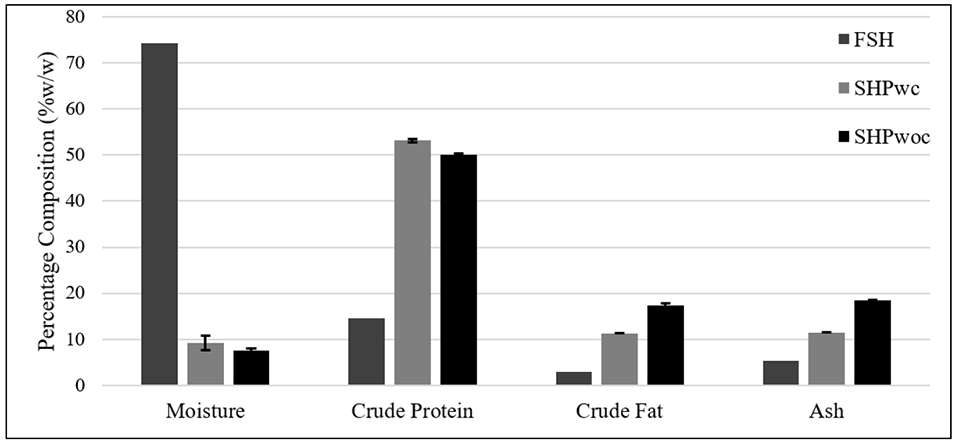
The microbiological quality of dried products is significantly affected by lowering water activity [water activity reflects the amount of water that is biologically available to microorganisms. It also affects a product’s texture, color, taste, shelf life and nutritional value. Each microorganism species (bacteria, yeast, mold, others) has a minimum water activity value below which growth is no longer possible] to less than 0.60, where no microbial proliferation is expected. In this regard, the water activity values in our data (for SHPwc it was 0.12 ± 0.001 and for SHPwoc 0.09±0.005) indicate that both shrimp head powders are microbiologically safe. In terms of solubility in water, the developed shrimp head powders have a low solubility value compared with the other powder produced from seafood processing wastes, possibly due to high amounts of insoluble ash or minerals in our dried shrimp shells and wastes.
Another essential property of a product is bulk density, which indicates flow and compressibility, thus determining the appropriate container size and concentration of food upon reconstitution of powder if prepared from a given volume. The bulk density values we obtained for both SHPs are relatively higher than those reported by other researchers for other seafood processing wastes. The high bulk density of our SHPs means that the powder particles tend to stick together or are compressed.
Regarding the sensory evaluation, shrimp odor and flavor of our shrimp powders were readily perceivable from the prepared 10 percent solution, probably due to its high solubility. Other researchers have reported that the highest non-essential amino acid found in their shrimp flavor powder was glutamic acid, which stimulates the mouth receptors for umami taste [umami is one of the five key taste profiles which also includes sweet, bitter, sour, and salt. From Japanese, it translates as “pleasant, savory taste”]. These results show that both products are generally acceptable, but the SHPwoc was noted to have higher acceptability.
Reduced growth performance of black tiger shrimp infected with IHHNV
As for product shelf-stability, all our samples were deemed safe and of good quality; however, SHPwoc was chosen over SHPwc based on some parameters. On preparation, SHPwoc production was noted to consume less effort and time during grinding and sieving. Salt and ascorbic acid were both added to enhance the shelf-keeping stability of the products. Ascorbic acid is an antioxidant that acts as a stabilizer for fats and oils, which also removes oxygen, in turn inhibiting oxidative rancidity in foods, while salt partially dehydrates microbial cells.
Results on the microbiological load of the products after monthly and seven months of storage at ambient temperature (28 to 30 degrees-C) show that the products are still safe for consumption, based on the Philippine Food and Drug Administration (FDA)’s microbiological criteria for frozen cooked crustaceans.
Product moisture has an increasing trend over time; however, it is still within the 25 percent moisture content for dried foods. This shows the effectiveness of the packaging material used in controlling moisture migration into the product. Rancidity also had an increasing trend over time. However, sensory evaluation was not performed to detect rancidity. Therefore, the most time recommended for storage without theoretically having off-flavors is six months.
Perspectives
Our results show the powders developed from P. monodon head wastes, both with and without carapace, are of high nutritional value and have acceptable physicochemical, microbiological and sensory qualities, and have promising qualities for further development. The shelf-life of our shrimp head powder without carapace can reach up to six months of storage.
We recommend that the use of shrimp head powder in the development of seafood products be explored, such as in seafood broths or soups, shrimp flavor seasoning, and the like. In addition, the use of adequate preservatives should also be further studied to optimize the application and improve the product’s shelf-life.
Now that you've reached the end of the article ...
… please consider supporting GSA’s mission to advance responsible seafood practices through education, advocacy and third-party assurances. The Advocate aims to document the evolution of responsible seafood practices and share the expansive knowledge of our vast network of contributors.
By becoming a Global Seafood Alliance member, you’re ensuring that all of the pre-competitive work we do through member benefits, resources and events can continue. Individual membership costs just $50 a year.
Not a GSA member? Join us.
Authors
-
Dr. Rosa A. Bassig
Corresponding author
Fisheries Postharvest Research and Development Division – Fish Handling and Processing Section, National Fisheries Research and Development Institute, Quezon City, Philippines -
Adoracion V. Obinque
Fisheries Postharvest Research and Development Division – Fish Handling and Processing Section, National Fisheries Research and Development Institute, Quezon City, Philippines
-
Vivian T. Nebres
Fisheries Postharvest Research and Development Division – Fish Handling and Processing Section, National Fisheries Research and Development Institute, Quezon City, Philippines
-
Virginia H. Delos Santos
Fisheries Postharvest Research and Development Division – Fish Handling and Processing Section, National Fisheries Research and Development Institute, Quezon City, Philippines
-
Deserie M. Peralta
Fisheries Postharvest Research and Development Division – Fish Handling and Processing Section, National Fisheries Research and Development Institute, Quezon City, Philippines
-
Ariel Joshua J. Madrid
Fisheries Postharvest Research and Development Division – Fish Handling and Processing Section, National Fisheries Research and Development Institute, Quezon City, Philippines
Tagged With
Related Posts
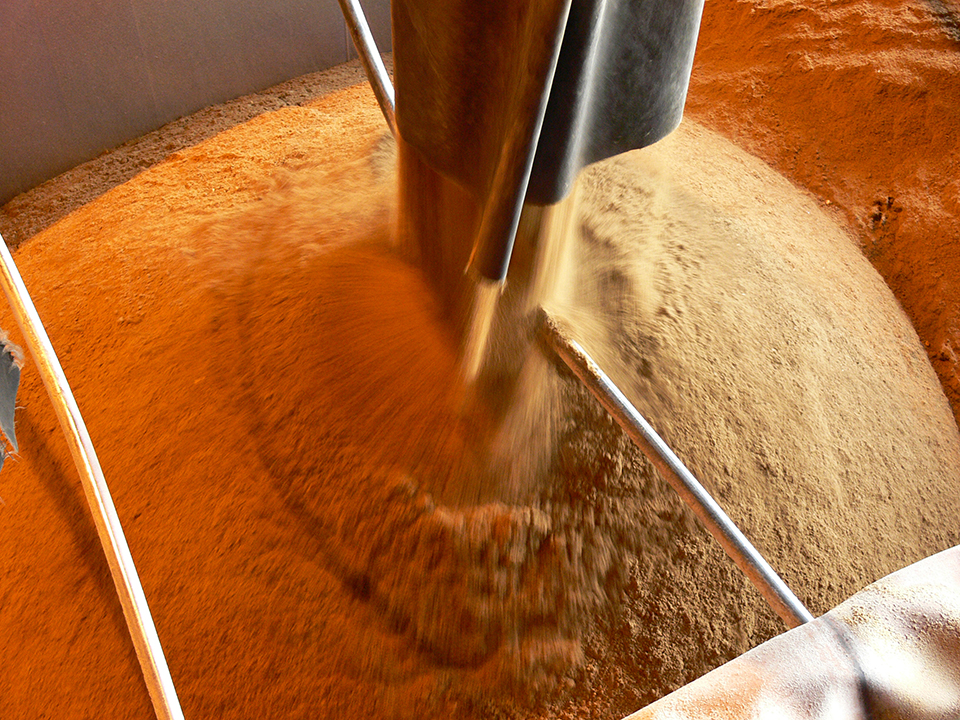
Aquafeeds
Animal byproducts can provide cholesterol for shrimp feed
Animal byproducts like blood meal, meat and bone meal and other rendered products are good sources of cholesterol for use in aquaculture feed.
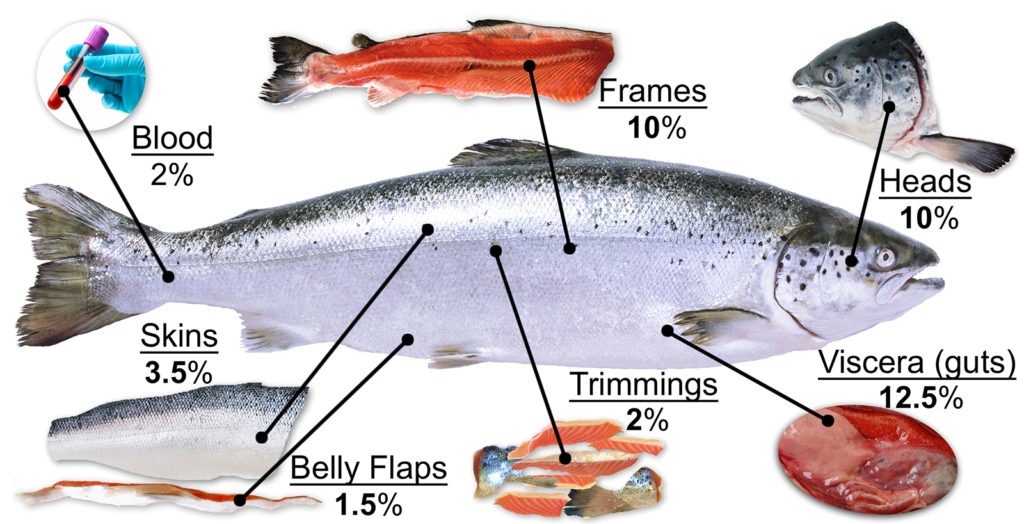
Aquafeeds
It takes guts to advance sustainability in aquaculture
With byproducts representing between 25 to 50 percent of the weight of various fish species, we need to be looking at how the entire fish is being used: even the heads, guts and skin.
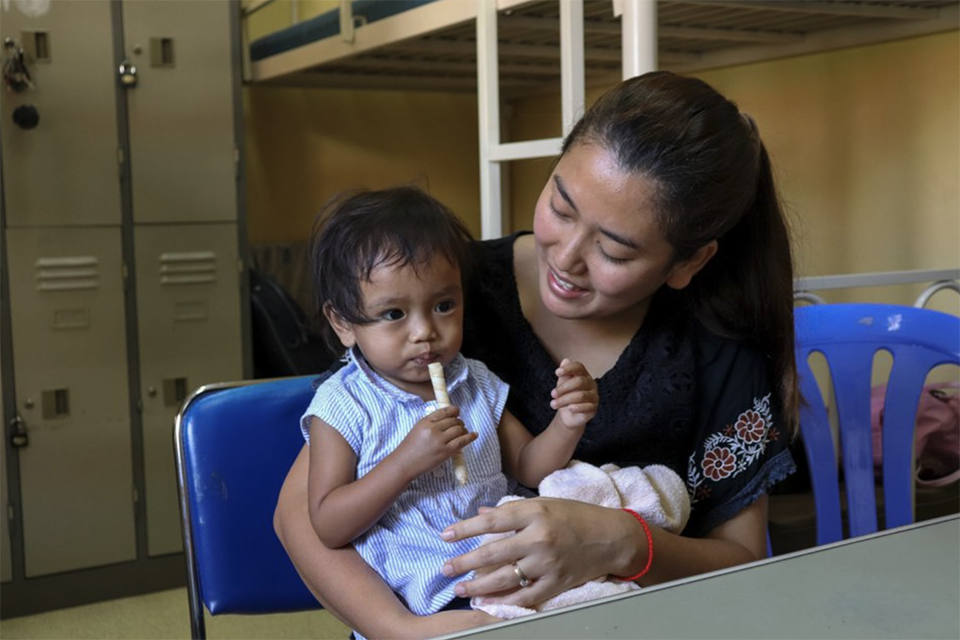
Responsibility
Eat the whole fish: A discussion of culture, economics and food waste solutions
The Big Fish Series explored the logistical and cultural challenges in front of greater whole-fish consumption and how much seafood is being wasted.
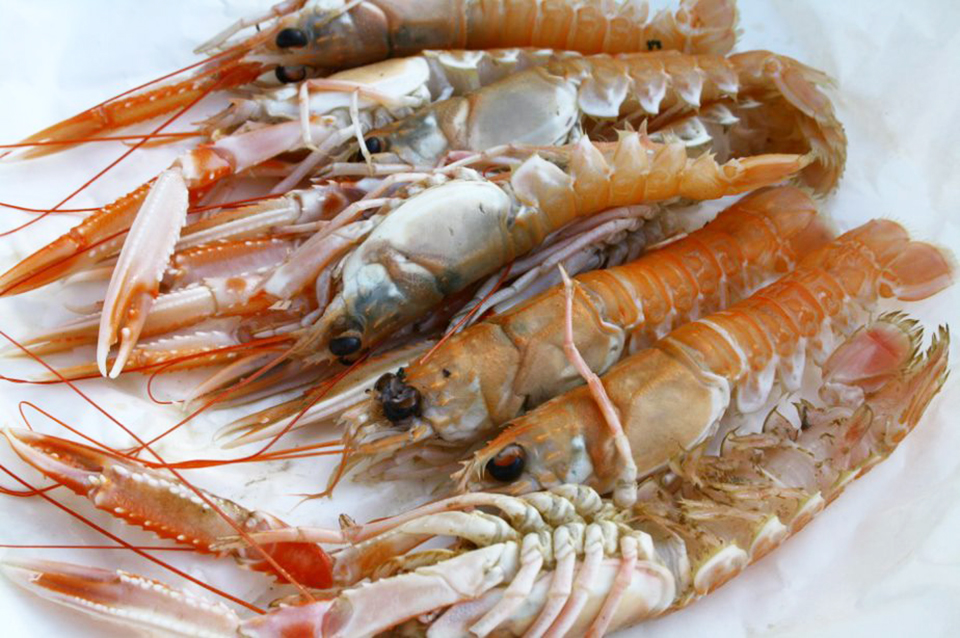
Innovation & Investment
Plastic 2.Ocean: Seafood packaging, made from shellfish
A new type of chitosan-based bioplastic, made from shellfish shells, emerges as a potential solution for global food waste and marine plastic pollution.



